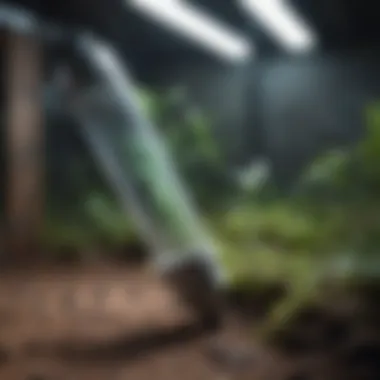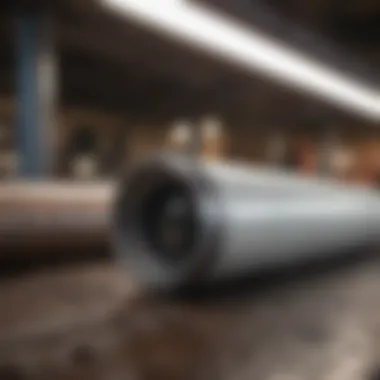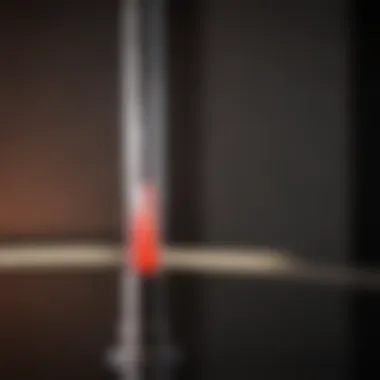Eco-Friendly Disposal of Fluorescent Light Tubes: Best Practices for a Sustainable Future


Overview of the Topic
Fluorescent light tubes, commonly used for indoor lighting, present a significant environmental concern due to the presence of potentially hazardous materials like mercury and phosphor. Improper disposal of these tubes can lead to pollution and pose risks to human health, making it crucial to adopt appropriate waste management practices.
Current Status and Challenges
The current state of fluorescent light tube disposal is worrisome, with many being discarded in regular household trash, ending up in landfills. This improper disposal method contributes to the release of toxic substances into the environment, creating a cycle of pollution. Challenges include raising awareness about safe disposal methods and enforcing regulations to ensure compliance across industries and households.
Sustainable Solutions
To address the pressing issue of fluorescent light tube disposal, sustainable solutions have emerged, focusing on recycling and proper waste disposal techniques. Initiatives promoting the collection and recycling of these tubes help reduce environmental impact by extracting and reusing valuable materials like glass and metals. Successful case studies underline the effectiveness of implementing dedicated recycling programs for fluorescent lighting fixtures, emphasizing the importance of resource recovery.
Impact and Importance
The impact of improper disposal of fluorescent light tubes resonates across ecosystems, posing risks to wildlife and water sources. Communities near landfills or incineration facilities are particularly vulnerable to the adverse effects of toxic substances leaching into the soil and groundwater. Emphasizing the importance of responsible waste management, conservation efforts play a vital role in mitigating the environmental consequences and preserving resources for future generations.
Introduction
Fluorescent light tubes have become an integral part of modern lighting solutions, offering efficiency and bright illumination. However, their disposal presents significant environmental challenges that require careful consideration. This article delves into the best practices and environmental considerations surrounding the proper disposal of fluorescent light tubes, aiming to enlighten readers on the crucial aspects of managing these ubiquitous lighting fixtures.
Understanding Fluorescent Light Tubes
The composition of fluorescent tubes
Fluorescent tubes typically consist of glass, a small amount of mercury, a phosphor coating, and electrodes. This composition allows for the efficient transformation of electrical energy into UV radiation and subsequently visible light. While the mercury content raises concerns about environmental impact, the overall design ensures optimal light output and energy efficiency, making them a popular choice for various lighting needs.
Risks associated with improper disposal
Improper disposal of fluorescent tubes poses numerous risks, primarily due to the mercury content. When broken or incinerated, these tubes release mercury vapor, a potent neurotoxin that can bioaccumulate in the environment. Exposure to mercury vapor presents significant health hazards to both humans and wildlife, emphasizing the critical importance of appropriate disposal methods.
Importance of Proper Disposal
Environmental impact


Proper disposal of fluorescent tubes is essential to minimize environmental impact. By preventing mercury leakage into soil and water sources, responsible disposal practices help protect ecosystems and biodiversity. Additionally, recycling fluorescent tubes reduces the need for raw materials, promoting resource conservation and sustainable waste management.
Health hazards
The improper handling of fluorescent tubes can result in severe health hazards. Mercury exposure, either through inhalation or skin contact, can lead to neurological damage, respiratory issues, and other serious health complications. Understanding and mitigating these health risks through proper disposal procedures are paramount to safeguarding human health and well-being.
Regulatory Framework
Laws governing fluorescent tube disposal
Many countries have specific regulations governing the disposal of fluorescent tubes due to their mercury content. These laws dictate the proper procedures for handling, transporting, and recycling these tubes to ensure minimal environmental impact and public health protection. Compliance with these laws is crucial for organizations and individuals to avoid legal repercussions and contribute to sustainable waste management practices.
Compliance requirements
Compliance requirements for fluorescent tube disposal focus on adherence to established guidelines for collection, recycling, and disposal processes. These requirements often include training on safe handling practices, maintaining accurate disposal records, and working with licensed waste management facilities. Ensuring compliance not only mitigates environmental risks but also demonstrates a commitment to ethical and responsible waste management practices.
Safe Disposal Methods
In this article, understanding the safe disposal methods for fluorescent light tubes is crucial. Safe disposal not only mitigates environmental impact but also ensures compliance with regulations. One specific element to focus on is the proper handling of these tubes to prevent breakage and leakage of harmful substances such as mercury. Implementing safe disposal methods significantly reduces health hazards for individuals involved in the disposal process. Furthermore, considering safe disposal methods guarantees that these widely used lighting fixtures do not contribute to pollution or contaminate the environment.
Recycling Options
Local recycling facilities
Local recycling facilities play a pivotal role in the safe disposal of fluorescent light tubes. Their key characteristic lies in providing accessible drop-off points for individuals and businesses to recycle these tubes efficiently. This option is beneficial as it promotes community engagement in environmental conservation efforts. The unique feature of local recycling facilities is their convenience and ease of use, making them a popular choice for those seeking sustainable disposal solutions. While local recycling facilities offer a convenient way to recycle fluorescent tubes, some drawbacks include limited operating hours and specific drop-off locations that may not be easily accessible to all.
Manufacturer take-back programs
Manufacturer take-back programs contribute significantly to the overall goal of safe disposal of fluorescent tubes. These programs stand out for their seamless process of returning used tubes to manufacturers for proper recycling or disposal. The key characteristic of manufacturer take-back programs is the accountability placed on producers to manage the end-of-life products they introduce into the market. This environmentally friendly choice ensures that materials from disposed tubes are recycled efficiently, minimizing waste. A unique feature of manufacturer take-back programs is that they often incentivize consumers to return used tubes by offering discounts or rebates on future purchases. However, challenges may arise in the accessibility of these programs, depending on the reach and participation of manufacturers.
Disposal at Household Hazardous Waste Facilities
Steps to take


Proper disposal at household hazardous waste facilities requires specific steps to ensure safety and compliance. These steps include securely packaging fluorescent tubes to prevent breakage during transportation and disposal in designated collection containers. The key characteristic of following these steps is the reduction of health and environmental risks associated with improper disposal practices. This beneficial choice guarantees that hazardous materials in the tubes are contained and managed appropriately, safeguarding public health and the environment. A unique feature of these steps is their simplicity, making it easy for individuals to adhere to regulations and guidelines for safe disposal. However, potential disadvantages may include limited access to designated facilities for some communities, requiring alternative disposal methods.
Finding nearby facilities
Locating nearby household hazardous waste facilities is essential for facilitating proper disposal of fluorescent light tubes. The key characteristic of these facilities is their specialized infrastructure to handle hazardous materials safely. This beneficial choice allows individuals to dispose of tubes in an environmentally responsible manner, reducing the risk of contamination. A unique feature of finding nearby facilities is the convenience they offer to the community, promoting regular disposal practices to prevent accumulation of hazardous waste in households. However, challenges such as limited operating hours or distant facility locations may hinder accessibility for some individuals, necessitating alternative disposal arrangements.
Professional Disposal Services
Benefits of using professional services
Engaging professional disposal services offers several benefits for individuals and businesses seeking safe disposal solutions for fluorescent light tubes. The key characteristic lies in the expertise and experience of professionals in handling hazardous materials, ensuring compliance with regulations and environmental standards. This beneficial choice guarantees efficient and proper disposal of tubes, minimizing risks and liabilities for clients. A unique feature of professional disposal services is the comprehensive nature of their disposal processes, including documentation and tracking of waste to meet regulatory requirements. However, potential disadvantages may include higher costs associated with professional services compared to DIY disposal methods.
Cost considerations
Considering the costs of professional disposal services is essential for making informed decisions on the most suitable disposal option for fluorescent tubes. The key characteristic of cost considerations is the transparency and itemization of service charges, covering collection, transportation, and recycling or disposal fees. This beneficial choice ensures clarity for clients regarding the financial aspects of safe tube disposal. A unique feature of cost considerations is the potential for negotiation of service fees based on the volume and frequency of disposal requirements, offering flexibility for clients. However, cost considerations may pose challenges for individuals or businesses operating on constrained budgets, requiring a careful balance between service quality and affordability.
DIY Disposal Techniques
In this article, one crucial aspect that demands attention is DIY disposal techniques. It is imperative to understand the significance of handling fluorescent light tubes independently, considering various elements that contribute to effective disposal. DIY methods not only offer a sense of control but also promote environmental responsibility. By engaging in DIY disposal, individuals can directly impact the reduction of environmental harm caused by improper handling of these lighting fixtures. Moreover, DIY techniques provide an opportunity for individuals to take charge of the disposal process, aligning with the overarching theme of promoting sustainability and eco-conscious practices.
Handling Precautions
Steps to safely handle fluorescent tubes
When it comes to discussing the steps involved in safely handling fluorescent tubes, attention to detail is paramount. Safeguarding oneself from potential risks associated with broken tubes or mercury exposure is essential. Implementing proper handling techniques such as wearing protective gloves, using secure grips, and avoiding rough movements can significantly reduce the chances of accidents during tube disposal. Ensuring that tubes are carefully maneuvered and stored upright further minimizes the risk of breakage, safeguarding both individuals and the environment.
Protective gear requirements
The utilization of adequate protective gear is a foundational element in promoting safe handling practices during fluorescent tube disposal. The need for protective gloves, goggles, and masks cannot be overstated, considering the potential for mercury exposure and physical harm from broken glass. By prioritizing the use of suitable protective gear, individuals can mitigate health risks and enhance the overall safety of the disposal process. While protective gear adds a layer of precaution, its implementation underscores the importance of prioritizing personal safety and environmental well-being in fluorescent tube disposal endeavors.
Transportation Tips
Secure packaging


The concept of secure packaging plays a pivotal role in ensuring the safe transportation of fluorescent tubes for disposal. Utilizing durable materials such as cardboard boxes and padding, combined with secure sealing methods, enhances the protection of tubes during transit. Organizing tubes in a manner that prevents rolling or shifting reduces the likelihood of breakage and ensures that tubes arrive intact at their designated disposal facility. Incorporating secure packaging practices not only safeguards individuals handling the tubes but also minimizes the environmental implications of accidental breakage or spillage during transportation.
Preventing breakage
Preventing breakage is a fundamental consideration when transporting fluorescent tubes for disposal. By employing strategies such as gentle handling, avoiding stacking heavy objects on the tubes, and securing them in an upright position, the risk of breakage can be significantly minimized. Additionally, choosing appropriate transportation vehicles that provide stability and shock absorption further reduces the susceptibility of tubes to damage. Preventing breakage remains a key focus throughout the transportation process, emphasizing the need for diligence and care to maintain the structural integrity of fluorescent tubes until proper disposal is achieved.
Disposal Techniques
Proper methods for breaking and packaging
Delving into the proper methods for breaking and packaging fluorescent tubes showcases the precision and care required in this aspect of disposal. By following guidelines for dismantling tubes safely, individuals can efficiently separate components for recycling or proper disposal. Techniques such as using specialized tools for glass cutting and carefully containing mercury-containing elements highlight the meticulous approach needed for effective disposal. Proper packaging methods further ensure that broken components are secured and contained, minimizing the potential for environmental contamination and facilitating the recycling process.
Disposal in regular waste vs. recycling
The contrast between disposal in regular waste and recycling underscores the environmental considerations that shape disposal decisions. Opting for recycling over regular waste disposal offers numerous benefits, including resource conservation and reduced landfill waste. Recycling facilitates the extraction of valuable materials from fluorescent tubes while minimizing the strain on natural resources. In comparison, disposing of tubes in regular waste poses the risk of mercury contamination and contributes to landfill saturation. By choosing recycling as the preferred disposal method, individuals actively contribute to sustainable practices and environmental preservation.
Environmental Impact
In this insightful article on Disposing of Fluorescent Light Tubes, the focus shifts towards the Environmental Impact section, a critical aspect demanding careful consideration. Environmental Impact, as elucidated in this piece, entails a detailed exploration of the repercussions of improper disposal practices related to fluorescent light tubes. By centering on Environmental Impact, readers are exposed to the paramount importance of adopting responsible disposal methods to mitigate harm to the environment and uphold regulatory standards. The section unveils the profound significance of addressing issues such as resource conservation, reduced landfill waste, mercury contamination, and effects on wildlife throughout the disposal process, highlighting the interconnectedness of environmental sustainability and prudent waste management.
Recycling Benefits
Resource conservation
Resource conservation emerges as a pivotal facet in the realm of fluorescent light tube disposal. This practice accentuates the prudent utilization of valuable resources embedded within these devices, underscoring the need for sustainable resource management approaches. Resource conservation not only minimizes wastage of raw materials but also contributes to energy efficiency and ecological balance. The distinctive feature of resource conservation lies in its ability to promote circular economy principles, fostering a closed-loop system wherein materials are recycled and repurposed. This approach, endorsed within the article, showcases resource conservation as a strategic and environmentally conscious choice, offering long-term benefits and aligning with the overarching goal of waste reduction and environmental preservation.
Reduced landfill waste
Addressing the issue of reduced landfill waste within the context of light tube disposal unveils a crucial strategy for waste diversion and pollution prevention. By diverting fluorescent tubes from landfills through recycling initiatives, reduced landfill waste effectively minimizes the environmental burden associated with improper disposal practices. This key characteristic emphasizes the shift towards sustainable waste management practices, promoting a circular economy model where materials are reused or recycled instead of being discarded. The unique feature of reduced landfill waste lies in its ability to curb greenhouse gas emissions, preserve land resources, and mitigate soil and water contamination. Within this article, reduced landfill waste emerges as a sustainable and environmentally beneficial option, underscoring the importance of waste diversion strategies in reducing environmental impact and enhancing resource efficiency.
Hazards of Improper Disposal
Mercury contamination
The peril of mercury contamination looms large within the domain of improper fluorescent tube disposal, posing significant risks to environmental and human health. Considering the toxic nature of mercury present in these tubes, improper disposal practices can lead to severe environmental contamination and public health implications. This specific aspect, elucidated within the article, underscores the critical need for responsible and regulated disposal methods to prevent mercury leakage into ecosystems. The key characteristic of mercury contamination lies in its persistent threat to soil, water, and air quality, necessitating stringent measures to control its dispersal. By highlighting the detrimental effects of mercury exposure on human health and the environment, the article emphasizes the imperative of adopting safe disposal practices to curtail mercury contamination and safeguard ecological integrity.
Effects on wildlife
The profound effects of improper fluorescent tube disposal extend beyond human health to encompass the intricate web of wildlife ecosystems. The detrimental impacts on wildlife due to exposure to hazardous substances emanating from improper disposal practices are a cause for grave concern. Delving into the repercussions of wildlife exposure within the article, a comprehensive overview of the link between careless disposal methods and ecosystem disruption surfaces. The key characteristic of effects on wildlife lies in the disruption of food chains, habitat degradation, and biodiversity loss, underscoring the interconnectedness of environmental health and wildlife conservation. By shedding light on these critical concerns, the article advocates for responsible disposal practices that safeguard not only human well-being but also the delicate balance of wildlife habitats and species survival.



